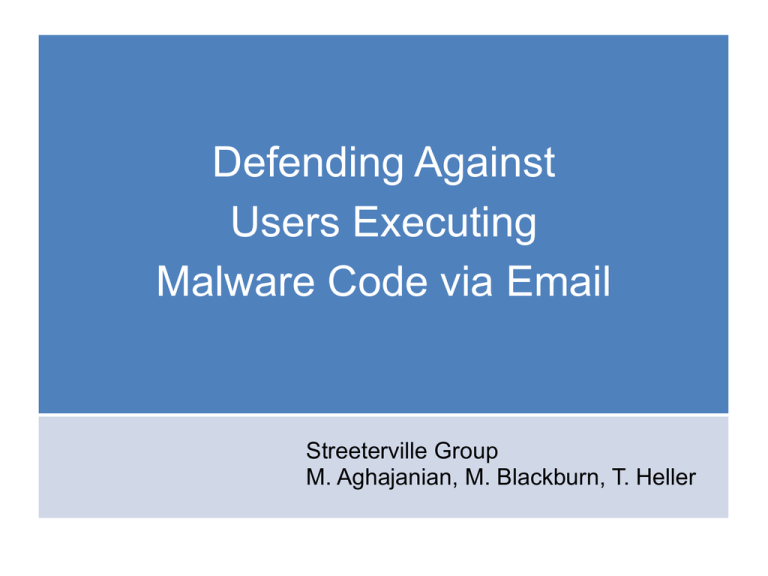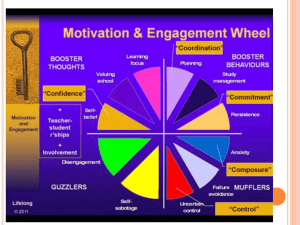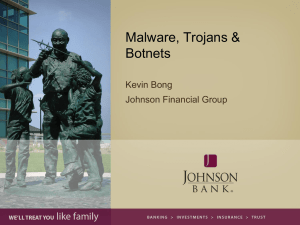Defending Against Users Executing Malware Code via Email
advertisement

Defending Against Users Executing Malware Code via Email Streeterville Group M. Aghajanian, M. Blackburn, T. Heller Introduction Case of Confounded Confections, Inc. • Ultra-secure network to protect their sweet secrets: 1. Enterprise firewalls. 2. Only necessary services with required authentication. 3. Tightly managed systems. • Anomalies begin to appear. • CIO wants to know… Investigation Why?! Risk Analysis Quick Review • • • • • • • • Risk analysis (quantitative) Policy Design Prevention Response or countermeasures Implementation Control Rinse and repeat... Risk Analysis Classifications • State of hosts: susceptible, infected, quarantined, recovered, transmitted, and healthy. • Size of host population: small (binomial), large (poisson). • Diversity of hosts (mix of operating systems) • Weight of susceptibility • Weight of business value Risk Analysis Risk Analysis General Cost of Malware • Paradigm shift to more indirect costs than direct costs overall. • Largest expenses: • Staff hours for support. • Staff hours from downtime. • Hardware, software, vendor support and IT training. • Legal, human resources, and training. Prevention at the Edge and Perimeter Design Solutions • Layered schema for malware detection. • Prevention by inspection at various points at the edge and perimeter. • ClamAV (open source hardware solution) • Microsoft perspective (proprietary software solution) • Future approaches at the edge or perimeter (next sections) Prevention at the Edge and Perimeter Layered Protection Microsoft Approach Responding to User Actions: Clicking on Links Exploitations Drive-By Downloads o Exploit browser vulnerabilities. JavaScript/ECMAScript Content Parsing o Exploit vulnerabilities in browser add-ons. Flash Adobe Reader Java Responding to User Actions: Clicking on Links Countermeasures • DNS Blacklisting o Used by spam filtering software. o Repurposed to everyday DNS. o Prevent access to sites known to host malware. o 11.25¢ per user/year. • SSL Proxy with malcode detection o Prevent all malcode delivery. o Including within encrypted sessions. Responding to User Actions: Clicking on Links Prevention—Human Factor • User Training o Detect Suspicious emails. o Close Browser if concerned. • Acceptable Use Policy o Discourage promiscuous behavior. o "Scare tactic" heightens stakes. • Ongoing Communication o Ongoing remediation costs = foregone benefits. o Reinforce desired behavior. Responding to User Actions: Clicking on Links Mitigation—Technical Approaches • Application Selection o Remove Adobe Reader: 55% of all attacks. o Remove IE6, 5% of all attacks. • Update policies o Use Microsoft Group Policy Update MS products automatically. o Communicate & inform users o Perform software audits Not feasible in decentralized networks. Responding to User Actions: Clicking on Links Mitigation—Human Factor • User cooperation o Accept new updates o Don't install unknown plugins • Vendor support o Push updates to all clients o Centralized patch level monitoring o Create vendor compliance standards Responding to User Actions: Opening Attachments Antivirus Signatures Typical approach Bit-by-bit signatures (a.k.a. "hash") o New approach Behavioral signature o Influence Script Kiddies o Policy and enforcement Additional software may be required Performance hit Instrumentation, Legacy systems o Responding to User Actions: Opening Attachments Policies and Enforcement • Antivirus/OS update policies and procedures o Responses to malware/vulnerabilities, a.k.a. Patches o Admins: greater freedom/power or computer security o If users choose when to update... o If admin chooses when to update... o "Managed" antivirus software Shows who is doing what: Privacy issues • Distributed Support System o Typical of universities o Policies and enforcement up to non-IT personnel Responding to User Actions: Opening Attachments OS Countermeasures • User privilege management o Usually centralized Environment and staff affect leniency Research environment requires more user privileges Less IT staff requires more user privileges Requirements, Reactions & Risk Users have different tasks, downtime, productivity requirements • Vendor/Instrumentation/Legacy computers o Limited support, no software patching (Vendor not liable) o Various versions of antivirus software o User POV Updating is confusing, lengthy, slower computer and system reboot Responding to User Actions: Opening Attachments Execution and Service Management • OS's require password authorization before execution o Protects against "accidentally" installing unwanted software o Users can enter password and move on • DEP & ASLR o Windows XP SP2, Mac OS X o Effective as individual solution o Exploits written for IE8 and Firefox (Mac & Win) o Defense-in-Depth: Makes exploits slower Layering defenses: more obstacles, more opportunities Responding to User Actions: Opening Attachments Future Approaches • Network level sandbox o Users adept to waiting for emails • Deep-scanning email clients o Number of cores/cpu's growing & Privacy issues • Research: Extent of malware coders sharing/upgrading malware • Executable signatures • Non IT Policies o High level policies (HIPPA, SOX) Cause more IT support funding and detail Force everyone to abide (legal consequences) • Northwestern University o Proactive policies, training










